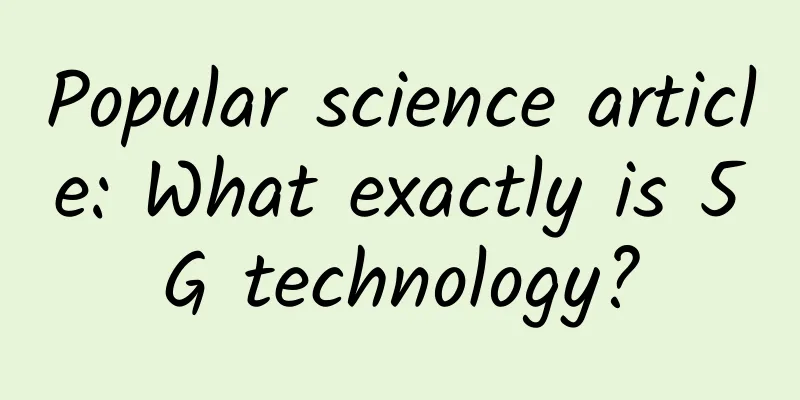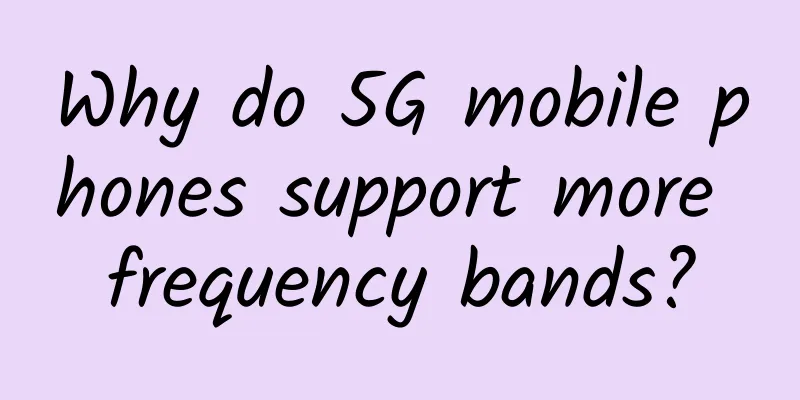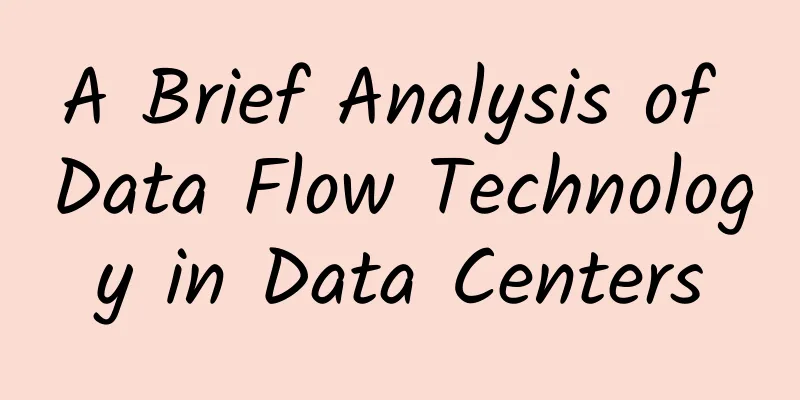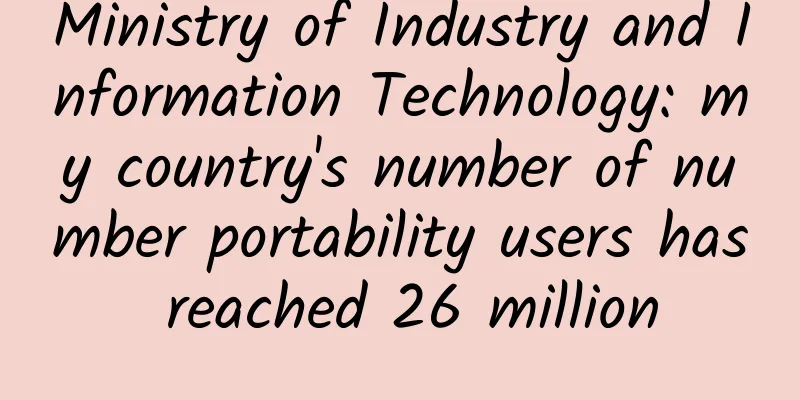Popular science article: What exactly is 5G technology?

|
Introduction As a post-80s generation, from the time I can remember until now, my family and I have experienced the transition from fixed-line telephones and dial-up Internet access to broadband access, speed increases and fee reductions, from Internet cafe chat rooms, home desktops to tablet computers, from floppy disks and hard disks to USB flash drives and cloud storage, from BP machines, mobile phones, PHS to smartphones. In just two or three decades, the communications in my life have undergone earth-shaking changes. When I first entered college, I had my first 2G mobile phone, with a TFT screen, 32-chord ringtones, and a 30-yuan/month package from the "M-Zone". It seems like it was just yesterday. Today, our country is about to usher in the 5G era. From the gradual popularization of mobile phones by 1G, 2G, and 3G, to today's vigorous 4G, and the upcoming full commercial use of 5G, my country's mobile communications industry has achieved remarkable development achievements in the world in the 40 years of reform and opening up, which has truly benefited everyone. On the occasion of the 70th anniversary of the founding of New China, we hereby write a 5G popular science article to make an effort to help people further understand 5G and welcome 5G. Wang Tan, National Radio Monitoring Center 5G Technology Popularization The G in 5G is the abbreviation of Generation, which means "generation". Therefore, 5G is the abbreviation of the "fifth generation" mobile communication system. This is the same as the fifth ring having one more ring than the fourth ring. There are many articles on the history of the evolution of mobile communications, so this article will not go into details.
From 1G to 4G, each generation of mobile communication has brought us a brand new experience. Simply put, 1G is voice service, 2G is "txt" or short message, 3G is "jpg" or picture and other multimedia services, 4G is "avi/mkv" and other video services, so what is 5G going to do? 5G ambitions First of all, 5G is certainly better than 4G in terms of serving the daily communication needs of ordinary people. This is also 5G's specialty, one of the three major scenarios: enhanced mobile broadband (eMBB). Let's first see how much 5G has improved in terms of capabilities compared to 4G in this regard. According to an Internet report, the world's fastest 4G network speed (average 63 Mb/s) and the fastest broadband network speed (average 189 Mb/s) combined are not as high as 5G's network speed (theoretically up to 10Gb/s). 5G's network speed can completely crush them.
Figure 1 5G network speed comparison chart The substantial increase in network speed can be transformed into many enhancements, such as: faster download speed (download of high-definition movies in seconds), higher video quality (1080p, 4k, 8k is not a dream), more advanced multimedia service mode (virtual reality immersive experience, augmented reality, etc.), support for more users online at the same time at the same existing data rate, or significantly reduce the latency of a single user (reduce network freezes and waiting time), etc. But if you think that 5G is only capable of this, you are wrong. The real "ambition" of 5G is not to connect people, but to connect people and things, and things and things. In short, the real goal of 5G is to connect everything. This includes the other two of the three major scenarios of 5G: highly reliable and low latency (URLLC) and massive machine communication (mMTC). What is highly reliable and low latency? This shows the ability of 5G to connect everything quickly, accurately and fiercely. For example, when a person is driving, the brain reaction time from noticing a situation to stepping on the brake is generally 10 to 50 milliseconds (that is, 1%-5% of 1 second), while the low latency of 5G requires a capability of 1 to several milliseconds. In addition, 5G requires five nines (99.999%) of communication reliability. With this capability, playing mobile games, browsing the web, and watching videos will not allow you to understand the power of 5G technology. Only in communication scenarios with high precision and time requirements such as autonomous driving, industrial control, and telemedicine can 5G maximize its technical advantages.
In terms of large-scale machine communications, 5G demonstrates the dimension and breadth of connecting everything. 5G can support access to 1 million devices per square kilometer, which is 10 times that of 4G. As 5G's ability to connect everything gradually penetrates into every aspect of our daily lives, our TVs, refrigerators, washing machines, speakers, lights, water, electricity and gas meters, door locks in our homes, street lights, vehicles, traffic lights, cameras, logistics in the city, every video camera at sports events, concerts, and parties, production lines, shelves, and robotic arms in factories, sensors and water pipes in farmland, sensors and monitors carried by every patient, every piece of food and medicine, etc., can all have their own "sim card" in the 5G network and can establish a direct connection with your mobile phone. Figure 3 Schematic diagram of 5G large connection Note that these devices will be able to connect directly to 5G in the future, rather than connecting to your phone indirectly through home WiFi or other channels. At this time, you can truly realize the ultimate vision of 5G: "information at your fingertips, everything at your fingertips" through a 5G phone.
A brief introduction to 5G technology The above "ambition" of 5G is by no means groundless, because 5G has a package of new communication technologies to achieve its goals. Let's talk about it in detail here. Communication technology, no matter what black technology or white technology, is divided into only two types - wired communication and wireless communication. Normally, the voice and data in your mobile phone (including the information you click in various apps and other operations) are first transmitted to the nearby base station through radio waves, and then transmitted to the core network for processing through optical fiber. Next, if you want to connect to other people or things, the relevant messages will be forwarded to the base station near your communication target, and then transmitted to the other party's mobile phone or computer and other terminals by radio waves; if you are unilaterally obtaining Internet services, it is the core network that connects to other Internet resources (such as video playback, etc.) and transmits the feedback corresponding to your request back to you. Figure 5 Schematic diagram of communication transmission path It is easy to achieve high speed for wired communication. In the laboratory, the maximum speed of a single optical fiber has reached 26Tbps (1Tbps = 1000 Gbps = 1000×1000 Mbps), which is 26,000 times that of traditional network cables. However, wireless communication transmission is the bottleneck of the entire channel.
The above paragraph may confuse you. Simply put, the road of information transmission must first go through a small and narrow road of "wireless communication", and then converge to the ultra-wide high-speed highway of "wired communication". When it is the "last kilometer" from the destination, it will go down from the main road to the small road of "wireless communication" and finally reach the destination. Therefore, the wireless communication section is the part that 5G focuses on widening and speeding up. In addition, network technology reflects the efficiency of 5G in processing information, feedback information, and providing services in the network, which is also the content that 5G needs to evolve. The following are introduced separately. 5G wireless technology "troika" There are three main dimensions for wireless communication to increase capacity: First, improve the "point-to-point" network speed from mobile phones and other terminals to base stations; that is, make the "small roads" of wireless communication mentioned above smoother and smoother, so that the speed of vehicles can be directly increased. Second, increase the number of base stations, increase the opportunities for mobile phones and other terminals to connect to base stations nearby; that is, build more small roads leading to the main roads, so that vehicles can quickly get on the highway nearby; third, add more spectrum, that is, make the small roads wider, so that more cars, wider and larger cars can run on the small roads at the same time, and run more smoothly. Figure 7: The three pillars of 5G wireless technology development No matter which generation of mobile communication evolves, these three "horses" will go hand in hand. So what black technologies does 5G have in these three aspects? Black technology 1: Beamforming of large array antennas In order to improve the speed of "point-to-point" information transmission, 5G has greatly increased the number of antennas, from 2 transmitters and 2 receivers in traditional 4G to 8 transmitters and 4 receivers in the post-4G era. In 5G, it is now called a large array antenna, which is "large" to 64, 128 or even 512 antennas. Figure 8 What are the benefits of a large array antenna? This is where the black technology of beamforming comes in. By adjusting the transmission of each antenna, the array antenna can achieve a shaped and directional beam emitted by the entire antenna array. A traditional antenna is like a large street lamp, with the light bulb facing downward or in a fixed direction. Although it can illuminate a person at a certain location and provide him with services, a lot of light energy is directed to other places where no one is (there is no need to initiate communication services), resulting in a great waste of energy. The beamforming provided by the large array antenna is like a spotlight, which directs the light beam to the person who needs to be illuminated. This saves energy consumption on the one hand, and makes the local area brighter and the communication quality better on the other hand. In addition, there is no need to worry that the increase in the number of antennas will lead to greater radiation from 5G base stations. In fact, under the same frequency band and coverage conditions, the transmission power of a single 5G base station has not increased significantly. The array antenna makes better use of the benefits of multi-path propagation of radio waves in space to increase the communication rate. Some people may ask, will increasing the number of 5G base stations increase radiation? Please continue reading. Black Technology 2: Dense Networking of Micro Base Stations Simply put, there are two types of base stations, micro base stations and macro base stations. As the name implies, micro base stations are very small, while macro base stations are very large. A macro base station usually covers a large area, several kilometers or even more than ten kilometers. In the future, there will be more micro base stations, which will be installed everywhere and can be seen everywhere, each covering about 200 to 300 meters. So will adding base stations lead to increased radiation? On the contrary, the more base stations there are, the less radiation there is! Just imagine: in a house with a group of people in winter, is it better to have one high-power heater or several low-power heaters? Therefore, the smaller the base stations are and the more they are, the better the coverage and the faster the speed, allowing more mobile phones to access the highway nearby. Black Technology 3: 5G New Spectrum Spectrum is the path for wireless communication. The amount of spectrum resources directly corresponds to the width of the 5G wireless communication path. So, what is the difference between 5G spectrum and 3G/4G? What do mid-band and millimeter wave refer to? I will keep you in suspense for now, please refer to the spectrum section below. In summary, 5G has new breakthroughs and progress in the three dimensions of wireless technology. Of course, the 5G technology family is far more than what is mentioned above, there are also powerful technologies such as polarization code and new frame structure, which I will not expand on here. 5G Network Technology After talking about 5G wireless technology, let's take a look at network technology. The main goal of the evolution of network technology, simply put, is to improve the response speed and accuracy of base stations after receiving requests from various terminals such as mobile phones. As mentioned earlier, 5G's biggest "ambition" is to expand to the Internet of Things. In addition to daily communications for ordinary people, it must also solve communication problems in various vertical industries. In addition, 5G also sets itself extremely demanding requirements for high reliability and low latency. So how does 5G's network technology cope with it? Here we focus on two black technologies. Black Technology 4: Network Slicing The reason why 5G networks can serve a variety of vertical industry application scenarios is that network slicing technology is undoubtedly one of the most important technologies. Network slicing is to logically divide network resources into multiple independent private networks, also known as "virtual private networks", according to the requirements of different business applications for the number of users and service quality. Each slice is completely independently defined, and users can deploy the network quickly and flexibly. The 5G network is like a Swiss Army knife, with multiple functions such as a knife, scissors, saws, bottle openers, bottle openers, nail clippers, etc. (serving the public, industry, electricity, transportation, logistics, home, etc.). If the user has a demand, the system will break off some functions. Black Technology 5: Mobile Edge Computing Before talking about mobile edge computing, let's briefly review the development and changes of the terminal's "computing" capabilities. Here, "computing" refers to the computing work that must be processed on mobile phones and other terminals for communication. In the early days, all computing was done on the terminal. Later, people found that on the one hand, terminal computing had bottlenecks (computing speed caused by terminal size, battery consumption, etc.), and on the other hand, there were many public and idle computing resources on the entire Internet, and the capabilities were far greater than those of the terminal. Therefore, distributed computing and cloud computing were proposed, that is, the computing workload required locally was moved to the network side, and the results were returned to you after the calculation was completed. The benefit of cloud computing is that it greatly improves the efficiency of terminals in obtaining computing results, but in certain cases it also increases the delay of information transmission. Now, 5G requires ultra-low latency in milliseconds. In order to meet this indicator, people have proposed mobile edge computing, which uses wireless access networks to provide services and computing functions nearby, creating a high-performance, low-latency and high-bandwidth service environment, accelerating the rapid download of various content, services and applications in the network, and allowing consumers to enjoy an uninterrupted high-quality network experience. For example, in a family, the wife manages the money (5G core network), and the husband (base station) has to apply to his wife every time he spends money (initiates calculation) (transmits information to the core network). If the husband is in a hurry to pay the bill (requires low latency), but he has not responded to his wife's consent (large latency), it may lead to a very poor experience; but if the wife allows the husband to spend less than 200 yuan without asking for permission (authorizes part of the calculation to edge computing), then the execution efficiency of small matters of spending money at home will be significantly improved (achieve low latency). |
<<: In-depth understanding of the working principle of VLAN with pictures and texts, don't miss it
>>: A curve shows what stage 5G, autonomous driving, and AI have reached
Recommend
WiFi, Bluetooth, NFC, three major technologies covered in one article!
Wi-Fi, Bluetooth, NFC, I believe everyone is fami...
5 IT industry trends to watch in 2021
[[389534]] According to a recent survey report re...
Network security protection under large-scale deployment of IPv6 - Seven questions and answers on IPv6 security technology
Due to its huge address space, IPv6 has a natural...
The greater development of 5G lies in industrial applications
[[181724]] Some people say that 4G has changed ou...
An article to help you understand the HTML web page layout structure
[[404070]] Hello everyone, I am IT sharer, also k...
Why Thread will unify IoT communication protocols in the future
Various devices connected to the Internet of Thin...
The future is here. How can operators accelerate innovation in blockchain applications?
At present, there are more than 1,400 blockchain ...
edgeNAT VPS 20% off for monthly payment and 30% off for annual payment, Hong Kong/Korea/US data centers available, top up 500 yuan and get 100 yuan free
edgeNAT has just launched a promotion for this mo...
A big competition among operators’ 5G strengths!
Recently, according to the latest news from the M...
What you should know about 5G
When it comes to 5G, the most classic and intuiti...
spinservers: 10Gbps bandwidth high-end server, monthly payment of $139, dual E5 2630Lv3/256GB/2×1.92T SSD/Dallas
spinservers has sent us new promotional machines,...
Huawei's Hu Houkun: Connecting to create a better intelligent world
On December 20, the 2022 China Unicom Partner Con...
How is the VoLTE development of the three major operators?
There are always various opportunities for indust...
Wi-Fi 6 deployment exceeds 5G, will Wi-Fi 6 become the next generation of wireless network?
In addition to popular devices such as smartphone...
Are there fake Gigabit routers? Have you ever avoided these manufacturers' pitfalls?
The story of how home networks are as slow as a s...









